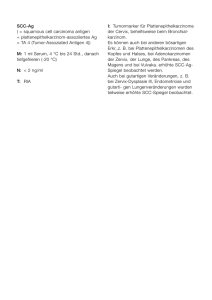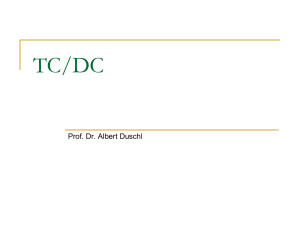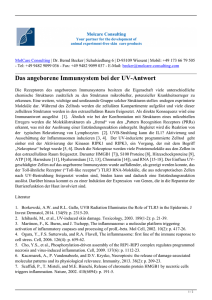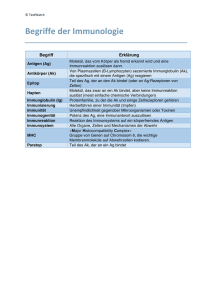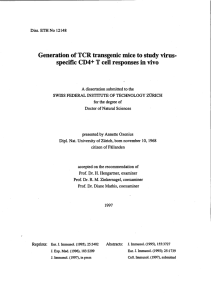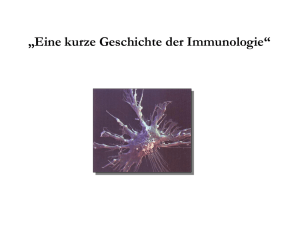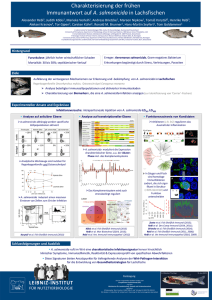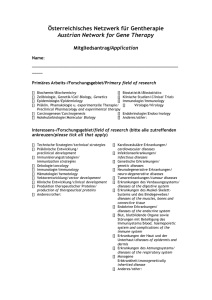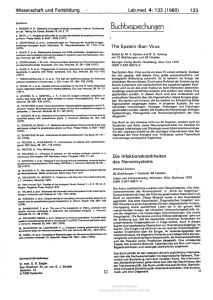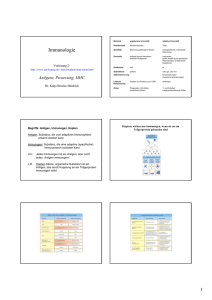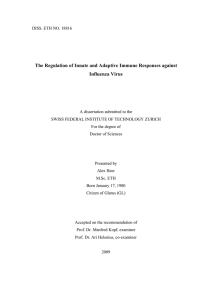Abstract
Werbung
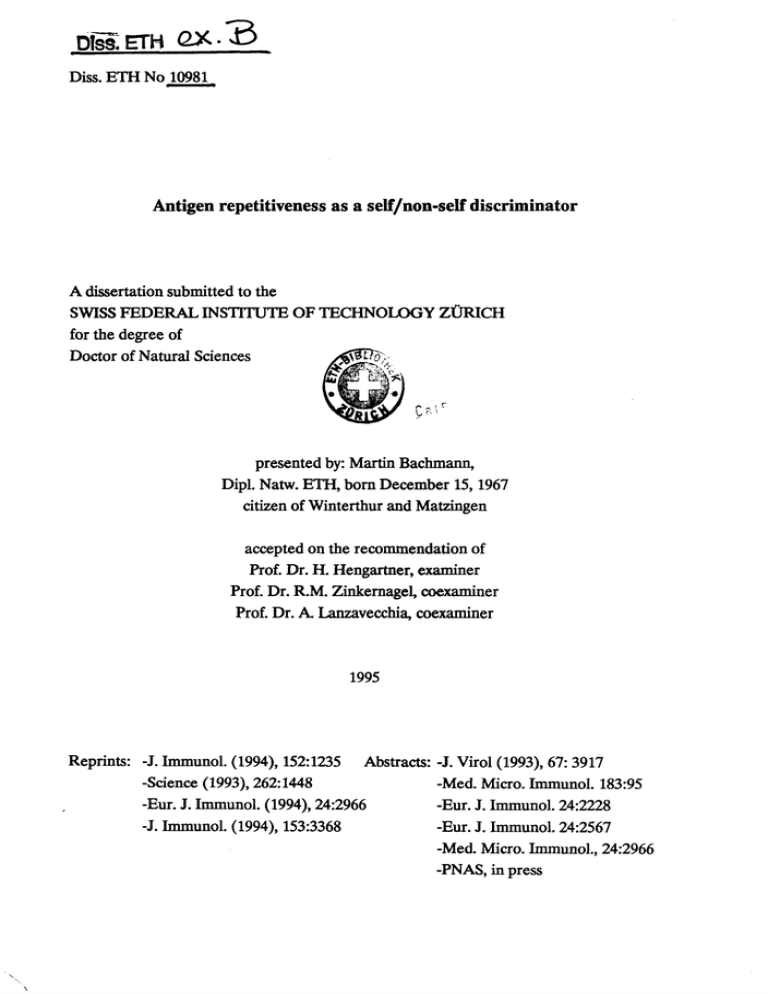
DTsSETH ox.3 Diss. ETH No 10981 Antigen repetitiveness self/non-self discriminator as a A dissertation submitted to the SWISS FEDERAL INSTITUTE OF TECHNOLOGY ZURICH for the degree of Doctor of Natural Sciences presented by: Dipl. Natw. Martin Bachmann, ETH, bora December 15,1967 citizen of Winterthur and accepted on Prof. Dr. H. Prof. Dr. R.M. Prof. Dr. A. Matzingen the recommendation of Hengartner, examiner Zinkernagel, coexaminer Lanzavecchia, coexaminer 1995 Reprints: -J. Immunol. -Science (1994), (1993), Abstracts: -J. Virol (1994), (1994), (1993), 67:3917 -Med. Micro. Immunol. 183:95 262:1448 -Eur. J. Immunol. -J. Immunol. 152:1235 24:2966 153:3368 -Eur. J. Immunol. 24:2228 -Eur. J. Immunol. 24:2567 -Med. Micro. Immunol., 24:2966 -PNAS, in press -5- Summaiy The specific while immune system selectively responds against foreign antigens (pathogens) distinguish foreign between lymphocytes, self-antigens. towards remaining unresponsive specific of of the immune system ontogenetic development i) random selection generation of lymphocyte receptors (i.e. elimination) pathogens iv) and memory. present, questions repertoire of 100 times as a specificities per happens by negative either model discrimination is also repetitiveness) foreign of the antigen: a a to current is mouse much or, if later, in a more ensuing development more form organized the (due the degree antigen, B cell response. the chapter 1 vesicular 10^_6 B self-antigen to the lack of (an) cells, self/non-self of the organization (i.e. more Finally, chapter likely 4 is immunological it is dealing memory. different sorts of memory B cells, the highly activated, strictly antigen dependent antibody forming dependent, freely recirculating analysed using i.e. dogmas, self/non-self discrimination tolerizing are two In restricted number of of the immune system: results suggest that there the known at are a mouse. 2 and 3 will indicate'that for B The process: 10*0 specificities, self-specific lymphocytes, encountering and the less controlled the presented multistep theoretical calculations, the to possible differently, namely by with the last step of the The According signal(s)). Chapters cell level. The lymphocytes, constituting may be in the range of antigen, revealing early during development additional a mouse or lymphocytes recognizing than the actual number of B cells in selection of as a a possible specificities, ii) negative activation of According remain open. mouse. single the be described with all section, the B cell repertoire of stomatitis virus on many details about these processes Although Since possible by elimination (deletion of these useful expansion specificities, more can self-specific cells, iii) B cell receptors of of the result cell of stable immunological some is cells and does therefore act self-specific able to immune response, express receptors of single specificity only, self/non-self discrimination silencing) be must (self/non-self discrimination). and self-structures the mediators of the this, it To classical memory B cells. cells and the less antigen -6- Zusammenfassung Das spezifische Immunsystem reagiert wahrend es nicht Selbstantige gegen spezifischen AntigenspezifMt exprimieren, Elimination (Deletion Einzelzell Niveau oder geschehen. Prozess beschrieben werden: mit reagiert. Deshalb muss es Immunantwort sind, Anergisierung) Die iv) dauerhafte Ontogenese immunologischen bleiben noch Repertoire uberhaupt einige Fragen ca. Zellen hat. In Die dieser brauchbaren offen. Nach theoretischen 10^ Spezifitaten, Kapitel ist, namlich geschieht, ca. (d.h. Elimination) die ein Pathogen Lymphozyten von erkennen was zum dass auch noch anders des Antigens: ein die tolerogenen 2 und 3 werden aktivierten, die weniger antigenabhangigen, strikte untersucht. Diese B Zell moglich ist, Je Repertoire einer es das Antigen, antigenabhangigen (wegen in fehlender Organisationsgrad desto eher ist es hervor. Das abschliessende immunologische von der dass fur B Zellen diese namlich durch den organisierter B Form aufzeigen, zwei verschiedene Formen die einer selbst/nicht-selbst Unterscheidung behandelt den letzten Schritt der Immunantort, das es als sie Repertoire Selbstantigen entweder friih in einer und desto effizientere B Zell Antworten ruft Resultate deuten an, dass das B Zell Spezifitaten Modell-Antigen praktisch verfugbare Lymphocyten Signale). Kapitel (d.h. Repetitivitat) Berechnungen umfasst 10^-10^ Spezifitaten. Ontogenese treffen oder, falls spater, Unterscheidung durch Zellen auf dem 1 des Resultate-Teils wird das B Zell lassen vermuten, dass das costimulierender einer nur kann als Mehrschritt dh. etwa 100 mal mehr gangige heutige Vorstellung besagt, dass dadurch mit Lymphozyten-Rezeptoren von Selektion Maus mit dem Vesikularen Stomatitis Virus als Maus viel kleiner Lymphocyten, Gedachtnis fiihrt. Obwohl viele Details dieser Prozesse bekannt sind einer Maus Experimente Rezeptoren Immunsystems des i) Zufallige Generierung Expansion Da selbstspezifischen von selbstspezifischen Zellen, iii) Aktivierung von Lymphozyten und zwischen selbst und selbst/nicht-selbst Unterscheidung kann diese moglichen Spezifitaten, ii) Negative alien Antigene (Pathogene) (selbst/nicht-selbst Unterscheidung). fremd unterscheiden konnen welches die Effektoren der selektiv gegen fremde fremd Kapitel Gedachtnis. Die Gedachtnis B Zellen gibt, Zellen, welche Antikorper produzieren und frei rezirkulierenden klassischen Gedachtniszellen.
